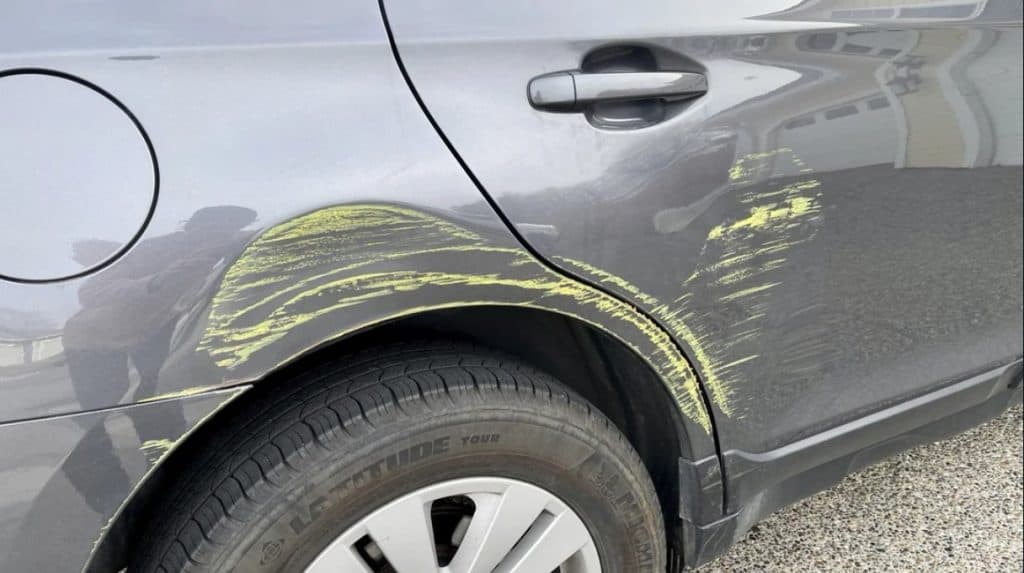How To Carry Out Paint Transfer Removal On Your Car
Your car’s paint job is vulnerable to a wide range of hazards, and one common issue that car owners may encounter is paint transfer. Paint Transfer Removal On Your Car occurs when another object, such as another car, a shopping cart, or a pole, scrapes against your vehicle, leaving behind a mark of its paint on the surface. This can be frustrating, as it mars the appearance of your car. Fortunately, paint transfer removal is a relatively straightforward process that can be performed at home without professional help. In this guide, we will take you through step-by-step instructions on how to safely and effectively remove paint transfer from your car.

Materials Needed
Before you begin, gather the following materials:
- Microfiber towels
- Car wash soap
- Water
- Clay bar kit
- Car polish (non-abrasive)
- Car wax or sealant
- Applicator pads
- Rubbing alcohol (isopropyl alcohol)
- Spray bottle
- Waterless car wash solution (optional, for spot cleaning)
Step-by-Step Guide
- Inspect the Damage: Before proceeding, inspect the paint transfer marks carefully. If the transfer is light and superficial, it might be easily removable. However, if it has penetrated deep into the clear coat, you may need to seek professional help to avoid damaging your car’s paint.
- Wash the Car: Begin by washing your car thoroughly using car wash soap and water. This step helps remove any dirt and debris that could cause additional scratches during the paint transfer removal process. Rinse the car and pat it dry with a microfiber towel.
- Clay Bar Treatment: A clay bar is a useful tool for removing contaminants from the car’s surface, including paint transfer. Follow the instructions on your clay bar kit and lubricate the car’s surface with the provided lubricant. Gently glide the clay bar back and forth across the paint transfer area until the contaminants are lifted. Remember to frequently fold the clay bar to expose a clean surface.
- Spot Cleaning with Waterless Car Wash (Optional): For smaller paint transfer marks, you can use a waterless car wash solution to spot-clean the affected areas. Spray the solution on the paint transfer and gently wipe it away with a microfiber towel.
- Apply Rubbing Alcohol: Dip a clean microfiber towel into rubbing alcohol (isopropyl alcohol) and dab it on the paint transfer. Gently rub the area in a circular motion, allowing the alcohol to break down and lift the transferred paint. Be careful not to apply too much pressure to avoid damaging the clear coat.
- Polishing: After removing the paint transfer, inspect the area. You may notice some faint marks or residue left on the clear coat. Use a non-abrasive car polish to buff the area gently. This step restores shine to the affected region and further diminishes any remaining marks.
- Wax or Sealant: To protect the freshly cleaned area, apply a layer of car wax or sealant using an applicator pad. This step not only adds a protective barrier but also enhances the car’s overall appearance.
- Final Inspection: After the wax or sealant has dried, use a clean microfiber towel to gently buff the treated area. Inspect the car under proper lighting to ensure all paint transfer has been successfully removed.
Preventive Measures of carrying out paint transfer removal on your car
To minimise the chances of paint transfer in the future, consider the following preventive measures:
- Park Wisely: Choose parking spaces away from crowded areas or potential hazards, such as shopping carts or poles.
- Maintain Safe Following Distance: Keep a safe distance from other vehicles on the road to reduce the risk of accidental paint transfer during driving.
- Use Car Protection Products: Apply paint protection films or ceramic coatings to create a protective barrier over your car’s paint, making it more resistant to scratches and paint transfer.
Importance of carrying out paint transfer removal on your car
Carrying out paint transfer removal on your car is of paramount importance for several reasons. Ignoring or neglecting this issue can lead to more significant problems in the long run, affecting both the appearance and the value of your vehicle. Here are the key reasons why it’s crucial to promptly address and remove paint transfer:
Preserve Your Car’s Aesthetics
The primary reason to remove paint transfer is to maintain your car’s aesthetics. Paint transfer marks can be unsightly, especially on a well-maintained vehicle. These marks can make your car look neglected and reduce its overall appeal. By removing the transferred paint, you restore your car’s original appearance and ensure it looks its best.
Prevent Corrosion and Rust
Paint serves as a protective layer for your car’s metal body against environmental elements, including moisture and oxygen. When paint transfer occurs, it often leaves exposed metal, which is susceptible to corrosion and rust formation. Corroded metal can lead to structural damage, reducing the integrity of the car’s body and potentially causing expensive repairs.
Maintain Resale Value
Whether you plan to sell or trade in your car in the future, its condition plays a crucial role in determining its resale value. Prospective buyers and dealers closely inspect a car’s exterior, and paint transfer marks can be a significant deterrent. By promptly removing paint transfer, you can enhance the resale value of your car and attract potential buyers.
Prevent Paint Damage Spread
Paint transfer is not a standalone issue; it can exacerbate other paint problems. If left untreated, paint transfer marks can lead to the spread of scratches and swirls in the clear coat and underlying layers. This can create a snowball effect, making the paint damage more extensive and challenging to repair.
Read more: How Hot Is Too Hot To Use Car Paint Touch-Up?
Protect Your Investment
A car is a significant investment, and proper maintenance is essential to protect that investment. Regularly addressing paint transfer and other minor damages will keep your car in good condition and extend its lifespan. It also reduces the need for costly repairs or repainting in the future.
Maintain Brand Image
For businesses that use vehicles for their operations, maintaining a clean and well-presented fleet is vital for brand image. Customers, clients, and the public perceive a company that takes care of its vehicles as more reliable and professional.
Personal Satisfaction
Many car owners take pride in the appearance of their vehicles. Keeping your car’s exterior in top-notch condition can give you a sense of personal satisfaction and pride in your ownership.
Conclusion
Removing paint transfer marks from your car is a crucial maintenance task that should not be overlooked. It not only enhances the vehicle’s appearance but also protects it from potential damage, corrosion, and loss of resale value. Regularly inspect your car for any signs of paint transfer and address them promptly using the appropriate removal techniques. By doing so, you can ensure that your car continues to look great, retain its value, and remain an enjoyable and safe means of transportation for years to come.
Read more: Unleashing Your Car’s Personality: A Look Into BodyTeq’s Custom Car Paint Services In London
Paint transfer removal on your car can be easily accomplished with the right materials and techniques. By following this step-by-step guide and taking preventive measures, you can keep your car’s paint looking pristine and prevent unsightly marks caused by paint transfer incidents. However, if the paint transfer is severe or you are uncertain about handling the process yourself, it is always best to seek professional assistance to avoid any accidental damage to your car’s paint job.

